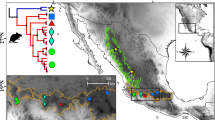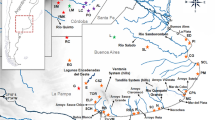Abstract
The relationships of Nesomyinae, a group of murid rodents endemic to the island of Madagascar, were investigated with two comparative molecular approaches. Compared to those of other muroid rodents representing Murinae, Cricetinae, Cricetomyinae. Arvicolinae, and Sigmodontinae, complete sequences of the 12S rRNA mitochondrial gene suggest that the Malagasy nesomyinesMacrotarsomys andNesomys are monophyletic and that their sister-group among the taxa analyzed isCricetomys. A limited series of DNA/DNA hybridization experiments extends these observations to a third nesomyine genus,Eliurus, and a second cricetomyine taxon,Saccostomus. By relating the amounts of overall genomic divergence with geological time as calibrated by theMus/Rattus dichotomy estimated at 12–14 My, the oldest within-Nesomyinae dichotomy is estimated to be 10.8 to 12.6 My. Thus, these three genera of Malagasy nesomyine rodents appear to be a rather ancient offshoot from African ancestors whose Recent relatives are Cricetomyinae. This preliminary observation should be confirmed by sampling additional genera of nesomyines and additional representatives for other subfamilies of African muroids.
Similar content being viewed by others
Literature Cited
Allard, M. W., and Honeycutt, R. L. (1992). Nucleotide sequence variation in the mitochondrial 12S rRNA gene and the phylogeny of African mole-rats (Rodentia: Bathyergidae).Mol. Biol. Evol. 9: 27–40.
Allard, M. W., Miyamoto, M. M., Jarecki, L., Kraus, F., and Tennant, M. R. (1992). DNA systematics and evolution of the artiodactyl family Bovidae.Proc. Natl. Acad. Sci. USA 89: 3972–3976.
Anderson, S., De Bruijn, M. H. L., Coulson, A. R., Eperon, I. C., Sanger, F., and Young, I. G. (1982). Complete sequence of bovine mitochondrial DNA. Conserved features of the mammalian mitochondrial genome.J. Mol. Evol. 156: 683–717.
Arnason, U., and Gullberg, A. (1993). Comparison between the complete mtDNA sequences of the blue and the fin whale, two species that can hybridize in nature.J. Mol. Evol. 37: 312–322.
Arnason, U., Gullberg, A., and Widegren, B. (1991). The complete nucleotide sequence of the mitochondrial DNA of the fin whale,Balaenoptera physalus.J. Mol. Evol. 33: 556–568.
Benveniste, R., Callahan, R., Sheer, C. J., Chapman, V., and Todaro, G. J. (1977). Two distinet endogenous type C viruses isolated from the Asian rodentMus cervicolor: Conservation of virogene sequences in related rodent species.J. Virol. 21: 849–862.
Bibb, M. J., Van Etten, R. A., Wright, C. T., Walberg, M. W., and Clayton, D. A. (1981). Sequence and gene organization of mouse mitochondrial DNA.Cell 26: 167–180.
Bremer, K. (1988). The limits of amino acid sequence data in angiosperm phylogenetic reconstruction.Evolution 42: 795–803.
Brownell, E. (1983). DNA/DNA hybridization studies of muroid rodents: Symmetry and rates of molecular evolution.Evolution 37: 1034–1051.
Carleton, M. D., and Musser, G. G. (1984). Muroid rodents. In:Orders and Families of Recent Mammals of the World, S. Anderson and J. K. Jones, eds., pp. 289–379, Wiley and Sons, New York.
Casanova, J.-L., Pannetier, C., and Kourilsky, P. (1990). Optimal conditions for directly sequencing double-stranded PCR products with sequenase.Nucl. Acids Res. 18: 4028.
Catzeflis, F. M. (1990). DNA hybridization as a guide to phylogenies: Raw data in muroid rodents. In:Evolution of Subterranean Mammals at the Organismal and Molecular Levels, E. Nevo and O. A. Reig, eds., pp. 317–345, Wiley-Liss, New York.
Catzeflis, F. (1991). Animal tissue collections for molecular genetics and systematics.Trends Ecol. Evol. 6: 168.
Catzeflis, F. M., Aguilar, J.-P., and Jaeger, J.-J. (1992). Muroid rodents: Phylogeny and evolution.Trends Ecol. Evol. 7: 122–126.
Catzeflis, F. M., Diekerman, A. W., Michaux, J., and Kirsch, J. A. W. (1993). DNA hybridization and rodent phylogeny. In:Mammal Phylogeny, F. S. Szalay, M. J. Novacek, and M. C. McKenna, eds., pp. 159–172, Springer Verlag, New York.
Chaline, J., and Mein, P. (1979),Les Rongeurs et l'évolution, Doin, Paris.
Chaline, J., Mein, P., and Petter, F. (1977). Les grandes lignes d'une classification évolutive des Muroidea.Mammalia 41: 245–250.
Chevret, P., Denys, C., Jaeger, J.-J., Michaux, J., and Catzeflis, F. (1993a). Molecular and fossil aspects of the tempo and mode of evolution inOtomys (Otomyinae: Muridae: Mammalia).Biochem. Syst. Ecol. 21: 123–131.
Chevret, P., Denys, C., Jaeger, J.-J., Michaux, J., and Catzeflis, F. M. (1993b). Molecular evidence that the spiny mouse (Acomys) is more closely related to gerbils (Gerbillinae) than to true mice (Murinae).Proc. Natl. Acad. Sci. USA 90: 3433–3436.
Chevret, P., Granjon, L., Duplantier, J.-M., Denys, C., and Catzeflis, F. M. (1994). Molecular phylogeny of thePraomys complex (Rodentia, Murinae): A study based on DNA/DNA hybridization experiments.Zool. J. Linn. Soc. 112: 425–442.
Conroy, G. C., Pickford, M., Senut, B., Van Couvering, J., and Mein, P. (1992).Otavipithecus namibiensis, first Miocene hominoid from southern Africa.Nature 356: 144–148.
Dickerman, A. W. (1992).Molecular Systematics of Some New World Muroid Rodents, Ph.D. thesis, University of Wisconsin, Madison.
Din, W., David, B., Laurin, B., Chaline, J., Harada, M., and Catzeflis, F. (1993). DNA/DNA hybridization study of the Clethrionomyini (Arvicolidae, Rodentia): Comparison with morphological and paleontological data.C. R. Acad. Sci. Paris (Ser. II) 316: 709–716.
Douzery, E. (1993). Evolutionary relationships among Cetacea based on the sequence of the mitochondrial 12S rRNA gene: Possible paraphyly of toothed-whales (odontocetes) and long separate evolution of sperm whales (Physeteridae).C. R. Acad. Sci. Paris (Ser. II) 316: 1511–1518.
Douzery, E., and Catzeflis, F. M. (1995). Molecular evolution of the mitochondrial 12S rRNA in Ungulata (Mammalia).J. Mol. Evol. 41: 622–636.
Ellerman, J. R. (1941).The Families and Genera of Living Rodents, British Museum (Natural History), London.
Farris, J. S. (1994).RNA, Molekylärsystematika laboratoriet, Nathurhistoriska riksmusseet, Stockholm.
Felsenstein, J. (1985). Confidence limits on phylogenies: An approach using the bootstrap.Evolution 39: 783–791.
Flower, B. P., and Kennett, J. P. (1993). Middle Miocene ocean-climate transition: High-resolution oxygen and carbon isotropic records from Deep Sea Drilling Project Site 588A, southwest Pacifie.Paleoceanography 8: 811–843.
Flynn, L. J., Jacobs, L. L., and Lindsay, E. H. (1985). Problems in muroid phylogeny: Relationships to other rodents and origin of major groups. In:Evolutionary Relationships among Rodents, W. P. Luckett and J.-L., Hartenberg, eds., pp. 589–616, Plenum Press, New York.
Gadaleta, G., Pepe, G., De Candia, G., Quagliariello, C., Sbisa, E., and Saccone, C. (1989). The complete nucleotide sequence of theRattus norvegicus mitochondrial genome: Cryptic signals revealed by comparative analysis between vertebrates.J. Mol. Evol. 28: 497–516.
Gutell, R. R., Weiser, B., Woese, C. R., and Noller, H. F. (1985). Comparative anatomy of 16S-like ribosomal RNA.Progr. Nucl. Acid Res. Mol. Biol. 32: 155–215.
Hänni, C., Laudet, V., Barriel, V., and Catzeflis, F. M. (1995). Evolutionary relationships ofAcomys and other murids (Rodentia, Mammalia) based on complete 12S rRNA mitochondrial gene sequences.Israel J. Zool. 41: 131–146.
Haq, B. U., Hardenbol, J., and Vail, P. R. (1988). Mesozoic and Cenozoic chronostratigraphy and cycles of sea-level change.Soc. Econ. Paleont. Mineral. Spec. Publ. 42: 71–108.
Hillis, D. M., and Huelsenbeck, J. P. (1992). Signal, noise, and reliability in molecular phylogenetic analyses.J. Hered. 83: 189–195.
Honeycutt, R. L., Nedbal, M. A., Adkins, R. M., and Janecek, L. L. (1995). Mammalian mitochondrial DNA evolution: A comparison of the cytochrome b and cytochrome c oxidase II genes.J. Mol. Evol. 40: 260–272.
Hugueney, M., and Mein, P. (1993). A comment on the earliest Spalacinae (Rodentia, Muroidea).J. Mammal. Evol. 1: 215–223.
Jacobs, L. L., and Downs, W. R. (1994). The evolution of murine rodents in Asia. In:Rodent and Lagomorph Families of Asian Origin and Diversification, Y. Tomida, C. Li, and T. Setoguchi, eds., pp. 149–156, National Science Museum Monographs, Vol. 8, Tokyo.
Jacobs, L. L., Flynn, L. J., Downs, W. R., and Barry, J. C. (1990). Quo vadis,Antemus? The Siwalik muroid record. In:European Neogene Mammal Chronology, E. H. Linday, V. Fahlbusch, and P. Mein, eds., pp. 573–587, Plenum Press, New York.
Jukes, T. H., and Cantor, C. R. (1969). Evolution of protein molecules: In:Mammalian Protein Metabolism. H. N. Munro, ed., pp. 21–123, Academic Press, Orlando, FL.
Kennett, J. P. (1985).The Miocene Ocean: Paleoceanography and Biogeography, Geological Society of America, Boulder, CO.
Kumar, S., Tamura, K., and Nei, M. (1993).MEGA: Molecular Evolutionary Genetics Analysis, Pennsylvania State University, University Park.
Lavocat, R. (1973). Les Rongeurs du Miocène d'Afrique Orientale. 1. Miocène inférieur.Mém Trav. EPHE Inst. Montpellier 1: 1–284.
Lavocat, R. (1978). Rodentia and Lagomorpha. In:Evolution of African Mammals, V. J. Maglio and H. B. S. Cooke, eds., pp. 69–89, Harvard University Press, Cambridge, MA.
Miyamoto, M. M., Tanhauser, S. M., and Laipis, P. J. (1989). Systematic relationships in the artiodactyl tribe Bovini (family Bovidae) as determined from mitochondrial DNA sequences.Syst. Zool. 38: 342–349.
Miyamoto, M. M., Kraus, F., and Ryder, O. A. (1990). Phylogeny and evolution of antlered deer determined from mitochondrial DNA sequences.Proc. Natl. Acad. Sci. USA 87: 6127–6131.
Musser, G. G., and Carleton, M. D. (1993). Family Muridae. In:Mammal Species of the World. A Taxonomic and Geographic Reference. D. E. Wilson and D. M. Reeder, eds., pp. 501–755, Smithsonian Institution Press, Washington, DC, and London.
Nedbal, M. A., Allard, M. W., and Honeycutt, R. L. (1994). Molecular systematics of hystricognath rodents: Evidence from the mitochondrial 12S rRNA gene.Mol. Phylogenet. Evol. 3: 206–220.
Petter, F. (1961). Affinités des genresSpalax etBrachyuromys (Rongeurs, Cricetidae).Mammalia 25: 485–498.
Petter, F. (1962). Monophylétisme ou polyphylétisme des rongeurs malgaches. In:Problèmes Actuels de Paléontologie (Evolution des Vertébrés), pp. 301–309, Centre National Recherche Scientifique, Paris.
Petter, F. (1990). Relations de parenté des rongeurs de Madagascar.Atti Convegni Lincei 85: 829–837.
Philippe, H. (1993). MUST, a computer package for management utilities for sequences and trees.Nucleic Acids Res. 21: 5264–5272.
Potter, M. (1986). Listing of stocks and strains of mice in the genusMus derived from the feral state.Curr. Topics Microbiol. Immunol. 127: 373–395.
Sabatier, M., and Legendre, S. (1985). Une faune à rongeurs et chiroptères Plio-Pléistocènes de Madagascar. In:Actes du 110éme Congrès National des Sociétés Savantes, pp. 21–28, CTHS, Paris.
Sambrook, J., Fritsch, E. F., and Maniatis, T. (1989).Molecular Cloning: A Laboratory Manual, Cold Spring Harbor Laboratory, Cold Spring Harbor, NY.
Sibley, C. G., and Ahlquist, J. E. (1990).Phylogeny and Classification of Birds: A Study in Molecular Evolution, Yale University Press, New Haven, CT.
Simpson, G. G. (1945). The principles of classification and a classification of mammals.Bull. Am. Mus. Nat. Hist. 85: 1–350.
Smith, M. F., and Patton, J. L. (1993). The diversification of South American murid rodents: Evidence from mitochondrial DNA sequence data for the akodontine tribe.Biol. J. Linn. Soc. 50: 149–177.
Smith, A. G., Smith, D. G., and Funnell, B. M. (1994).Atlas of Mesozoic and Cenozoic Coastlines, Cambridge University Press, Cambridge, UK.
Sokal, R. R., and Rohlf, R. J. (1981).Biometry, W. H. Freeman, San Francisco.
Sourrouille, P., Hänni, C., Ruedi, M., and Catzeflis, F. (1995). Molecular systematics ofMus crociduroides, an endemic mouse of Sumatra (Muridae: Rodentia).Mammalia 59: 91–102.
Springer, M. S., Davidson, E. H., and Britten, R. J. (1992). Calculation of sequence divergence from the thermal stability of DNA heteroduplexes.J. Mol. Evol. 34: 379–382.
Stehlin, H. G., and Schaub, S. (1951). Die Trigonodontie der simplicidentaten Nager.Schweiz. Paleont. Abhandl. 67, 1–385.
Swofford, D. L. (1993).PAUP: Phylogenetic Analysis Using Parsimony, Version 3. 1, Champaign, Illinois National History Survey.
Tamura, K. (1992). The rate and pattern of nucleotide substitution inDrosophila mitochondrial DNA.Mol. Biol. Evol. 9: 814–825.
Véron, G., and Catzeflis, F. (1993). Phylogenetic relationships of the endemic Malagasy carnivoreCryptoprocta ferox (Aeluroidea): DNA/DNA hybridization experiments.J. Mamm. Evol. 1: 169–185.
Werman, S. D., Springer, M. S., and Britten, R. J. (1990). Nucleic acids: DNA-DNA hybridization. In:Molecular Systematics, D. M. Hillis and C. Moritz, eds., pp. 204–249, Sinauer Associates, Sunderland, MA.
Winkler, A. J. (1994). The middle/upper Miocene dispersal of major rodent groups between southern Asia and Africa. In:Rodent and Lagomorph Families of Asian Origin and Diversification, Y. Tomida, C. Li, and T. Setoguchi, eds., pp. 173–184, National Science Museum Monographs, Vol. 8, Tokyo.
Author information
Authors and Affiliations
Rights and permissions
About this article
Cite this article
Dubois, JY., Rakotondravony, D., Hänni, C. et al. Molecular evolutionary relationships of three genera of nesomyinae, endemic rodent taxa from madagascar. J Mammal Evol 3, 239–260 (1996). https://doi.org/10.1007/BF01458182
Issue Date:
DOI: https://doi.org/10.1007/BF01458182




